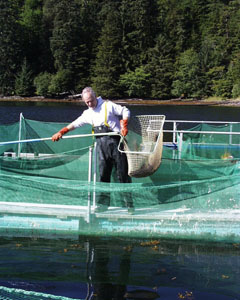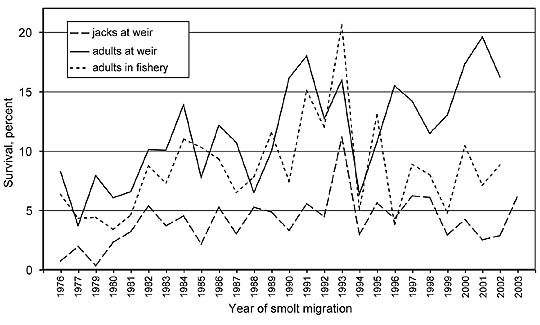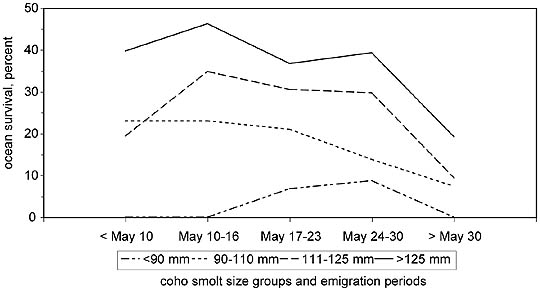| |

Alex Wertheimer.
|
Alex Wertheimer Receives Wally Noerenberg Award
Alex Wertheimer, a 30-year career scientist at the Auke Bay Laboratory (ABL),
recently received the Wally Noerenberg Award for Fishery Excellence from the
Alaska chapter of the American Fisheries Society. The award, named after a
former commissioner of the Alaska Department of Fish and Game (ADF&G), was
established by the Alaska chapter in 1982 and has been given only on eleven
other occasions. Wertheimer was recognized for his outstanding contributions to
Alaskaís fisheries resources, in particular his work in helping foster the
development and preservation of hatchery and wild salmon stocks in the state.
Among his research achievements, Wertheimer has played a major role in
developing a salmon stock enhancement program for Alaska through an innovative
approach using hatchery fish while protecting and maintaining large wild-stock
populations. Much of his current work focuses on the pink salmon hatchery
program and the wild salmon stocks in Prince William Sound. He is currently the
project leader for early ocean salmon research as part of the ABLís Marine
Salmon Interactions program and has authored or coauthored more than 30
peer-reviewed journal publications.
Wertheimer has served as Principal Investigator on several Exxon Valdez
Restoration Studies involving the effects of oil on salmon in the marine
environment. He also has played a major role in cooperation with ADF&G
in developing a state-wide Escapement Survey Database of salmon populations
from almost 4,000 streams and rivers. He serves on numerous committees
including the Chinook Technical Committee of the Pacific Salmon Commission,
is a former associate editor for Transactions of the American Fisheries
Society, and is a journal and symposium reviewer for numerous other national
and international technical publications in fisheries science.
Wertheimerís leadership, broad-ranging technical expertise, and professionalism
in dealing with individuals, other agencies, and controversial issues are widely
recognized and highly respected. His career in Alaska fisheries embodies what
the Wally Noerenberg Award is all about.
By Bill Heard.
Ocean Survival High for Auke Creek Wild Coho Salmon
Research at ABL’s Auke Creek field station includes evaluating the long-term
ocean survival of wild coho salmon (Oncorhynchus kisutch). While ocean
survival of coho salmon throughout much of their southern range has declined
over the previous three decades, in Southeast Alaska, which includes the
Auke Creek stock, survival of stocks has been increasing since at least 1980.

Figure 1. Ocean survival of Auke Creek coho salmon.
Coho salmon studies at Auke Creek are conducted under a cooperative project
between NMFS and the ADF&G that began in 1976; the Auke Creek coho salmon stock
is one of four wild stocks used as index systems in Southeast Alaska. Ocean
survivals of wild coho salmon at Auke Creek are known from 1976, when coded-wire
tags were first used on smolts leaving Auke Creek, to 2003 (excluding 1978; Fig.
1 above). The research at Auke Creek relies heavily on the permanent fish-counting
weir and wet laboratory space in the hatchery located adjacent to the weir site.
This project includes the annual capture and tagging of seaward-migrant
smolts, and capture and enumeration of fish returning to the creek. Auke
Creek is the only index site where all smolts are captured and marked,
and all adults are captured and examined for marks and tags.
Ocean survival of coho salmon smolts that emigrated from Auke Creek in 2002 was
28%. These smolts left Auke Lake and Auke Creek in 2002 and returned as jacks
later the same year and as 1-ocean winter adults in 2003; the 27-year average
marine survival for Auke Creek coho salmon is 24%. Coho salmon jacks (all males)
are common at Auke Creek and often equal the number of full-sized males from the
same smolt cohort. In 2002, 97 jacks returned to Auke Creek, for a 3% return of
the smolts marked and released that year; on average, the return to Auke Creek
as jacks is 247 fish, or 4% of the smolts.
The return of coho salmon adults to Auke Creek in 2003 was 551 fish, or 16% of
the smolts; the average return to Auke Creek is 665, or 12% of the smolts. The
harvest of 300 coho adults in the fishery was less than the average of 502, and
was a 9% return of smolts. The 2003 fishery harvested 35% of the coho adults
returning to Auke Creek, less than the 27-year average of 42%. Scales and size
data on the fish returning to Auke Creek were collected and archived in the files at ABL.
A separate study of the effects of coho salmon smolt size and emigration timing
at Auke Creek on ocean survival was recently completed. This 5-year study was
jointly funded by NMFS and the ADF&G and conducted as a University of Alaska
Fairbanks graduate project. The study involved a complex tagging effort at Auke
Creek where for each day all smolts were sorted into four size groups and tagged
with size- and day-specific tag codes. Tagged mature fish were recovered at Auke
Creek weir and in the fishery.

Figure 2. Ocean survival of Auke Creek coho salmon smolts in four size groups and five emigration periods.
The project showed that there is a complex interrelation between coho salmon
smolt size, and emigration time and ocean survival. Within emigration dates,
larger smolts survived at higher rates than smaller smolts, and between
emigration dates, there was an obvious period during which the highest survivals
occurred (Fig. 2 above). Most of the total return, jacks plus adults, originated from
the two largest size groups, which together produced 84% of the survivors. Most coho salmon jacks, 43% of the total jack return, originated from smolts greater
than 125 mm in length that emigrated in the 10-16 May period.
By Jerry Taylor.
>>>continued

|
 |
quarterly Oct-Dec 2003 sidebar
AFSC Quarterly
Research Reports
Oct-Nov-Dec 2003
Contents
Feature
Auke Bay Lab
National Marine
Mammal Lab
RACE Division
REFM Division
Quarterly Index
Quarterly Home
|

